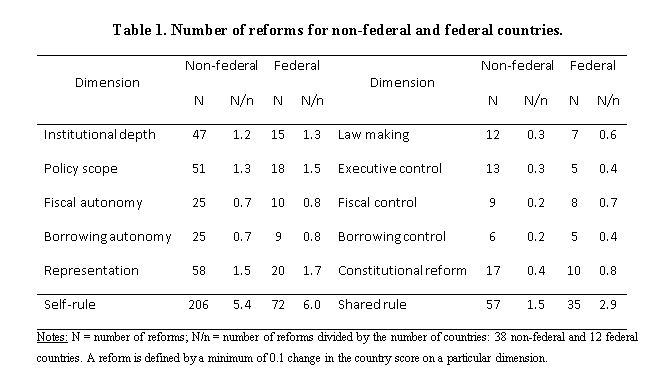Abstract
In this article I argue that federal scholars are well-advised to think of federalism as a continuum whereby subnational units can have more or less autonomy rather than allocating countries into federal and non-federal categories. The Regional Authority Index (RAI) measures the extent of self-rule and shared rule of regional government on an annual basis since 1950 and it reveals that regional autonomy arrangements in federal countries are more likely to be affected by reform than non-federal countries. In addition, self-rule appears to be the object of decentralization in non-federal countries whereas decentralization in federal countries has mostly affected shared rule. These are surprising results which come to the fore only when one escapes categorical thinking. The RAI also changes the way in which we think about the impacts of regional governance and thereby a whole new research agenda is being opened up.
Introduction
A question which intrigues many federal scholars is when a country can be called a federation. Asking this question, however, reduces federalism to an all or nothing issue. A country is federal, or it is not. Although this question has spurred a very interesting and theoretically useful debate on what defines federations, this debate has struggled to catch up with the quickly changing vertical state structures in many countries. Since the 1970s, a number of countries have introduced strong regional governments (e.g. Spain and the United Kingdom) and many countries have decentralised significant authority to regional tiers (e.g. France and Italy) or to specific regions (e.g. Åland Islands and Greenland). Federal scholars who have observed that autonomy arrangements were changing introduced new labels such as ‘quasi-federation’ (Aldecoa and Cornago, 2008), ‘regionalised state’ (Bassanini, 2012), ‘federacy’ (Wolff, 2004), and ‘federative system’ (Verney, 1995) to get a grasp on this new reality. However, these labels reveal that categorical thinking is still prevalent whereas it might be more useful to think of federalism and decentralisation as a continuum whereby subnational units can have more or less autonomy.
In this contribution, I first discuss the conceptual underpinnings and the details of the Regional Authority Index (RAI) which is a measurement of regional authority that provides scores for 81 countries since 1950 on an annual basis (Hooghe et al., 2016). The basic premise underlying the RAI is that regional authority should be understood as a continuous dimension. Second, I will illustrate the usefulness of the RAI by describing patterns of regional authority across 50 countries for which there is a continuous time series in developments in regional governance since 1950. Third, I conclude by laying out the main implications of the trends in regional governance revealed by the RAI.
The Regional Authority Index
The RAI is grounded in a well-established set of concepts. Authority is defined as legitimate power, that is, power recognised as binding because it is derived from accepted principles of governance (Dahl, 1968). Formal authority is defined as authority exercised in relation to explicit rules, usually written in constitutions, legislation, treaties or statutes. A regional government has some degree of authority, with respect to some territorial jurisdiction, over certain actions. The RAI therefore specifies: (A) the territory over which a government exercises authority; (B) the depth of that authority; and (C) the spheres of action over which it exercises authority.
- With respect to territorial scope of authority (A), a government may exercise authority in its own jurisdiction or co-exercise authority over a larger jurisdiction in which it is part. This is the distinction between self-rule and shared rule (Elazar, 1987). The expression of authority in self-rule, that is rule over those within the regional territory, is fundamentally different from that in shared rule, that is rule in the country as a whole.
- With respect to depth of authority (B), one needs to estimate the degree to which a government has an independent legislative, fiscal, executive organization, the conditions under which it can act unilaterally, and its capacity to rule when opposed by the national government.
- With respect to spheres of action (C), a regional or international government can have authority over a smaller or broader range of policies. Authority over taxation and borrowing, and over constitutional reform are especially important.
The RAI consists of two dimensions which each consists of five sub-dimensions. Self-rule is the authority exercised by a regional government over those living in its territory and is measured by:
- Institutional depth: the extent to which a regional government is autonomous rather than deconcentrated;
- Policy scope: the range of policies for which a regional government is responsible;
- Fiscal autonomy: the extent to which a regional government can independently tax its population;
- Borrowing autonomy: the extent to which a regional government can borrow;
- Representation: the extent to which a regional government has an independent legislature and executive.
Shared rule is the authority exercised by a regional government or its representatives in the country as a whole and is measured by:
- Law making: the extent to which regional representatives co-determine national legislation;
- Executive control: the extent to which a regional government co-determines national policy in intergovernmental meetings;
- Fiscal control: the extent to which regional representatives co-determine the distribution of national tax revenues;
- Borrowing control: the extent to which a regional government co-determines subnational and national borrowing constraints;
- Constitutional reform: the extent to which regional representatives co-determine constitutional change.
Each sub-dimension consists of several scores whereby higher scores indicate more authority. For example, a region that can set the rate of a minor tax such as a tax on tourists receives a score of 1 whereas a region which can set the base and rate of a major tax such as personal income, corporate, value added, or sales tax, receives a score of 4. Similarly, on the shared rule dimension, when regional governments or their representatives negotiate over the distribution of tax revenues but do not have a veto they receive a score of 1 but they receive a score of 2 when they do have a veto. Self-rule and shared rule scores are summed, and scores may vary in between zero (no regional government) to a maximum of 30. More detail on the measurement including detailed country profiles can be found in Hooghe et al. (2016).
Developments in Regional Authority across the Globe since 1950
The RAI traces developments in regional governance across time and for 12 federal and 38 non-federal countries and offers a continuous time series since 1950.[1] Figure 1 displays average self-rule plus average shared rule scores for non-federal (top) and federal countries (bottom). Not surprisingly, the averages for both self-rule and shared rule are much higher for federal than for non-federal countries.
Figure 1. Development in regional authority in non-federal and federal countries.


The amount of positive change in regional authority is higher for non-federal than for federal countries. The average self-rule score for non-federal countries doubled from 4.1 in 1950 to 8.2 in 2010 whereas the average for shared rule remained by and large constant (from 1.0 in 1950 to 1.1 in 2014). In contrast, the magnitude of change in the average self-rule score in federal countries has been much more modest and it increased from 15.2 in 1950 to 16.7 in 2010. In contrast, the average shared rule score did increase significantly from 5.8 in 1950 to 7.6 in 2010. The RAI reveals that overall change in regional authority has been much larger in non-federal than in federal countries. However, self-rule is the object of decentralization in non-federal countries whereas decentralization in federal countries has mostly affected shared rule.
Table 1 provides insight into the incidence of reform by displaying the number of reforms -defined as a minimum of 0.1 change in the country score- for each of the self-rule and shared rule dimensions. Because the number of countries differs between the non-federal and federal groups, I also divide the number of reforms by the number of countries within a group.

Three findings stand out in Table 1. First, the number of self-rule reforms is two to more than three times larger than the number of shared rule reforms. This may not be a much surprising result. It is easier to provide regions self-rule which involves a direct relationship between the central government and one region than to set up collective bargaining mechanisms among the central and all regional governments. Second, the number of reforms is much lower for the fiscal and borrowing dimensions. This finding clearly indicates that it is more difficult to change the ‘beholder of the purse’. It may also indicate that fiscal autonomy may be lacking behind relative to legislative autonomy which can make the latter an ‘empty shell’ since regions may find it difficult to pursue autonomy when their own fiscal resources are lacking. Third, the incidence of self-rule reforms is about equal among non-federal and federal countries. In contrast, there are twice as many shared rule reforms among federal countries than among non-federal countries. This indicates that reform in federal countries has been mostly centripetal, drawing constituent units into joint decision making. In non-federal countries, reform has been mostly centrifugal, giving regions greater self-rule without compensating reforms that give them greater responsibility for the country as a whole. This partitions authority across the territories of a country, but does not recombine authority in joint decision making. It conveys central authority to the regions, but does not convey the regions to central authority.
Conclusion
The findings of the RAI reveal that federal scholars are well advised to look beyond simple dichotomies or simple categorizations in case they would like to fully capture the growth in regional governance since 1950 in non-federal as well as in federal countries. Out of the grand total of 81 countries that the RAI includes, just one -Belgium- has become federal. Yet almost every non-federal country that is middle-sized or larger has been deeply affected by regional reform and the trend of increasing regional governance has left its mark in East and West and in developed and developing countries.
The results of the RAI change the way one looks at governance. No longer can governance be conceived as a once-and-for-all choice about which fork to take in the road of state creation: federal or unitary. This was the fundamental decision in the life of a country that shaped all others. The divide between federal and non-federal countries has narrowed. Non-federal countries may, like federal countries, have multiple levels of governance, directly elected regional assemblies, and strong regional executives collecting taxes, borrowing on financial markets, with extensive policy portfolios not subject to central veto. The key difference between a federal and a non-federal country lies not in the capacity of regions to rule themselves, but in their capacity to co-rule the country as a whole. Regions in federal countries are represented in countrywide second chambers in which they can co-determine national laws, including the distribution of national tax revenues. Many bargain directly with national governments over the budget and taxes.
The RAI will also change the way in which we think about the impacts of regional governance. To put it bluntly, instead of including a federal dummy as independent variable in the model, including the RAI enables a much more sophisticated view on when and how decentralization of authority matters. For example, increasing self-rule may lead to diverging party systems whereas shared rule may mitigate the centrifugal effects of self-rule. In other words, the RAI may open up a whole new research agenda.
The Regional Authority Index Dataset: http://garymarks.web.unc.edu/data/regional-authority/
[1] Federal countries: Argentina, Australia, Austria (since 1955), Belgium (since 1995), Brazil, Canada, Germany, Malaysia (since 1957), Mexico, Switzerland, United States, and Venezuela.
Non-federal countries: Bolivia, Chile, Colombia, Costa Rica, Cuba, Denmark, Dominican Republic, Ecuador, El Salvador, Finland, France, Greece, Guatemala, Haiti, Honduras, Iceland, Indonesia, Ireland, Israel, Italy, Japan, Luxembourg, Netherlands, New Zealand, Nicaragua, Norway, Panama, Paraguay, Peru, Philippines, Portugal, South Korea, Spain, Sweden, Thailand, Turkey, United Kingdom, and Uruguay.
Suggested Citation: Schakel, A. 2019. ‘Measuring Federalism and Decentralisation’. 50 Shades of Federalism. Available at:
Bibliography
Aldecoa, F. and N. Cornago (2008) “Kingdom of Spain,” in H. Michelmann, H. (ed.), A Global Dialogue on Federalism, Vol. 5; Foreign Relations in Federal Countries. Montreal and Kingston: Published for the Forum of Federations and the International Association of Centres for Federal Studies by McGill-Queen’s University Press, pp.240-68.
Bassanini, F. (2012) “Federalising a Regionalised State: Constitutional Change in Italy,” in A. Benz and F. Knüpling (eds.) Changing Federal Constitutions. Lessons from International Comparison. Opladen, Farmington Hills,MI: Barbara Budrich Publishers, pp.229-248.
Dahl, R. (1968) “Power,” in D.L. Sills (ed.), The International Encyclopedia of the Social Sciences. New York: MacMillan Free Press, 12, pp.405-415.
Hooghe, L., G. Marks, A.H. Schakel, S. Niedzwiecki, S. Chapman Osterkatz, S. Shair-Rosenfield (2016) Measuring Regional Authority. A Postfunctionalist Theory of Governance. Volume 1. Oxford: Oxford University Press.
Verney, D.V. (1995) “Federalism, Federative Systems, and Federations: The United States, Canada, and India,” Publius: The Journal of Federalism 25(2): 81-98.
Wolff, S. (2004) “The Institutional Structure of Regional Consociations in Brussels, Northern Ireland, and South Tyrol,” Nationalism and Ethnic Politics 10(3): 387-414.
Further Reading
Elazar, D.J. (1987) Exploring Federalism. Tuscaloosa: the University of Alabama Press.
Elazar, D.J. (1991) Federal Systems of the World: A Handbook of Federal, Confederal and Autonomy Arrangements. London: Longman.
Hooghe, L., and G. Marks (with A.H. Schakel, S. Niedzwiecki, S. Chapman Osterkatz, S. Shair-Rosenfield) (2016) Community, Scale, and Regional Governance. A Postfunctionalist Theory of Governance. Volume 2. Oxford: Oxford University Press.
Treisman, D. (2007) The Architecture of Government: Rethinking Political Decentralization. Cambridge: Cambridge University Press.
Watts, R.L. (2008) Comparing Federal Systems, Third Edition. Kingston, Ontario: McGill–Queen’s University Press.


 Arjan H. Schakel is Assistant Professor at the Department of Political Science at Maastricht University. His research interests comprise federalism, multilevel governance, regional elections, and regional parties. Arjan has co-developed the Regional Authority Index (with Liesbet Hooghe and Gary Marks) which has appeared in books by Routledge (2010) and Oxford University Press (2016) and he has edited two books on regional elections in 23 European countries (Palgrave Macmillan, 2013, 2017).
Arjan H. Schakel is Assistant Professor at the Department of Political Science at Maastricht University. His research interests comprise federalism, multilevel governance, regional elections, and regional parties. Arjan has co-developed the Regional Authority Index (with Liesbet Hooghe and Gary Marks) which has appeared in books by Routledge (2010) and Oxford University Press (2016) and he has edited two books on regional elections in 23 European countries (Palgrave Macmillan, 2013, 2017).